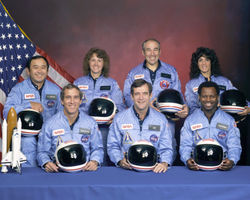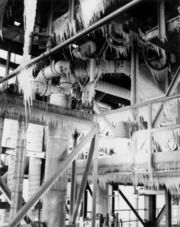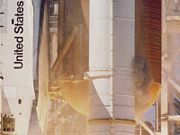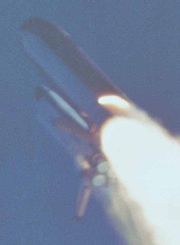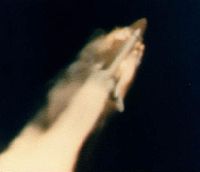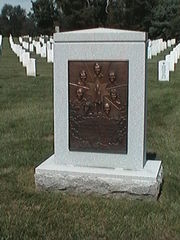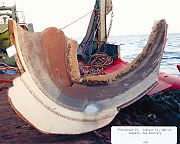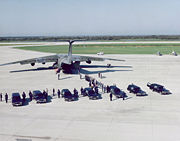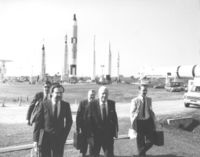Space Shuttle Challenger disaster
2008/9 Schools Wikipedia Selection. Related subjects: Engineering; Space transport
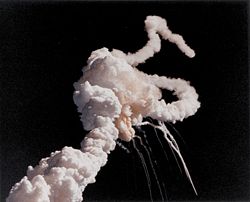
The Space Shuttle Challenger Disaster took place on January 28, 1986 when Challenger, a Space Shuttle operated by NASA, broke apart 73 seconds into its flight leading to the deaths of its seven crew members. The spacecraft disintegrated over the Atlantic Ocean, off the coast of central Florida, United States at 11:39 a.m. EST (16:39 UTC). Disintegration of the shuttle stack began 73 seconds into its flight after an O-ring seal in its right solid rocket booster (SRB) failed at liftoff. The seal failure caused a breach in the SRB joint it filled, allowing a flare to reach the outside and impinge upon the adjacent attachment hardware and external fuel tank. The SRB breach flare led to the separation of the right-hand SRB and the structural failure of the external tank. Aerodynamic forces promptly broke up the orbiter. The shuttle was destroyed and all seven crew members were killed. The crew compartment and many other vehicle fragments were eventually recovered from the ocean floor after a lengthy search and recovery operation.
The disaster resulted in a 32-month hiatus in the shuttle program and the formation of the Rogers Commission, a special commission appointed by United States President Ronald Reagan to investigate the accident. The Rogers Commission found that NASA's organizational culture and decision-making processes had been a key contributing factor to the accident. NASA managers had known that contractor Morton Thiokol's design of the SRBs contained a potentially catastrophic flaw in the O-rings since 1977, but they failed to address it properly. They also ignored warnings from engineers about the dangers of launching on such a cold day and had failed to adequately report these technical concerns to their superiors. The Rogers Commission offered NASA nine recommendations that were to be implemented before shuttle flights resumed.
Many viewed the launch live due to the presence on the crew of Christa McAuliffe, the first member of the Teacher in Space Project. Media coverage of the accident was extensive: one study reported that 85 percent of Americans surveyed had heard the news within an hour of the accident. The Challenger disaster has been used as a case study in many discussions of engineering safety and workplace ethics and inspired the 1990 television movie, Challenger.
Pre-launch conditions and delays
Challenger was originally set to launch from Kennedy Space Centre in Florida at 2:42 p.m. Eastern Standard Time (EST) on January 22. However, delays suffered by the previous mission, STS-61-C, caused the launch date to be pushed back to January 23 and then to January 24. Launch was then rescheduled to January 25 due to bad weather at the Transoceanic Abort Landing (TAL) site in Dakar, Senegal. NASA decided to use Casablanca as the TAL site, but because it was not equipped for night landings, the launch had to be moved to the morning ( Florida time). Predictions of unacceptable weather at Kennedy Space Centre (KSC) caused the launch to be rescheduled for 9:37 a.m. EST on January 27. According to Malcolm McConnell's book, Challenger: A Major Malfunction, NASA normally would have launched with the predicted forecast of a 50 percent chance of rain if not for plans to have Vice President George H. W. Bush stop over and watch the launch on his way to Honduras.
The launch was delayed the next day by problems with the exterior access hatch. First, one of the microswitch indicators used to verify that the hatch was safely locked malfunctioned. Then, a stripped bolt prevented the closeout crew from removing a closing fixture from the orbiter's hatch. When the fixture was finally sawn off, crosswinds at the Shuttle Landing Facility exceeded the limits for a Return to Launch Site (RTLS) abort. The crew waited for the winds to die down until the launch window finally ran out, forcing yet another scrub.
Forecasts for January 28 predicted an unusually cold morning, with temperatures close to 31 °F (−1 °C), the minimum temperature permitted for launch. The low temperature had prompted concern from engineers at Morton Thiokol, the contractor responsible for the construction and maintenance of the shuttle's SRBs. At a teleconference which took place on the evening of January 27, Thiokol engineers and managers discussed the weather conditions with NASA managers from Kennedy Space Centre and Marshall Space Flight Centre. Several engineers—most notably Roger Boisjoly, who had voiced similar concerns previously—expressed their concern about the effect of the temperature on the resilience of the rubber O-rings that sealed the joints of the SRBs. They argued that if the O-rings were colder than 53 °F (12 °C), there was no guarantee they would seal properly. This was an important consideration, since the O-rings had been designated as a "Criticality 1" component—meaning that there was no backup for them and their failure would destroy Challenger and its crew. They also argued that the low overnight temperatures would almost certainly result in SRB temperatures below their redline of 40 °F (4 °C). However, they were overruled by Morton Thiokol management, who recommended that the launch proceed as scheduled.
Due to the low temperature, a significant amount of ice built up on the fixed service structure that stood beside the shuttle. The Kennedy Ice Team inadvertently pointed an infrared camera at the aft field joint of the right SRB and found the temperature to be only 8 °F (−13 °C). This was the result of supercooled air blowing on the joint from the liquid oxygen tank vent. It was much lower than the air temperature and far below the design specifications for the O-rings. However, this information was never communicated to the decision makers.
Although the Ice Team had worked through the night removing ice—and not knowing of the super-cooled joint—engineers at Rockwell International, the shuttle's prime contractor, still expressed concern. Rockwell engineers watching the pad from their headquarters in Downey, California were horrified when they saw the amount of ice. They feared that during launch, ice might be shaken loose and strike the shuttle's thermal protection tiles, possibly due to the aspiration induced by the jet of exhaust gas from the SRBs. Rocco Petrone, the head of Rockwell's space transportation division, and his colleagues viewed this situation as a launch constraint, and told Rockwell's managers at the Cape that Rockwell could not support a launch. However, Rockwell's managers at the Cape voiced their concerns in a manner that led Houston-based mission manager Arnold Aldrich to go ahead with the launch. Aldrich decided to postpone the shuttle launch by an hour in order to give the Ice Team time to perform another inspection. After that last inspection, during which the ice appeared to be melting, Challenger was finally cleared to launch at 11:38 a.m. EST.
January 28 launch and failure
Liftoff and initial ascent
The following account of the accident is derived from real time telemetry data and photographic analysis, as well as from transcripts of air-to-ground and mission control voice communications. All times are given in seconds after launch and correspond to the telemetry time-codes from the closest instrumented event to each described event.
At 6.6 seconds before liftoff, the three space shuttle main engines (SSME) ignited. Until liftoff actually occurs, the SSMEs can be safely shut down and the launch aborted if necessary. At liftoff time (T=0, which was at 11:38:00.010 EST), the three SSMEs were at 100% of their original rated performance, and began throttling up to 104% under computer control. At this moment, the two SRBs were ignited and hold-down bolts were released with explosives, freeing the vehicle from the pad. With the first vertical motion of the vehicle, the gaseous hydrogen vent arm retracted from the External Tank (ET) but failed to latch back. Review of film shot by pad cameras showed that the arm did not re-contact the vehicle, and thus it was ruled out as a contributing factor in the accident. The post-launch inspection of the pad also revealed that kick springs on four of the hold-down bolts were missing, but they were similarly ruled out as a possible cause.
Later review of launch film showed that at T+0.678, strong puffs of dark grey smoke were emitted from the right-hand SRB near the aft strut that attaches the booster to the ET. The last smoke puff occurred at about T+2.733. The last view of smoke around the strut was at T+3.375. It was later determined that these smoke puffs were caused by the opening and closing of the aft field joint of the right-hand SRB. The booster's casing had ballooned under the stress of ignition. As a result of this ballooning, the metal parts of the casing bent away from each other, opening a gap through which hot gases above 5,000 °F (2,760 °C) leaked out. This had occurred in previous launches, but each time the primary o-ring had shifted out of its groove and formed a seal. Although the SRB was not designed to function this way, it appeared to work well enough and Morton-Thiokol changed the design specs to accommodate this process, known as extrusion.
Unfortunately, while extrusion was taking place, hot gases would leak past, a process called blow-by, damaging the o-rings until a seal was made. Investigations into the matter by Morton-Thiokol engineers determined that the amount of damage to the o-rings was directly related to the time it took for extrusion to occur, and that cold weather, by causing the o-rings to harden, lengthened the time of extrusion.
The morning of the disaster the o-ring was too cold to seal in time. The secondary O-ring was not in its seated position due to the metal bending. There was now no barrier to the gases, and both O-rings were vaporized across 70 degrees of arc. However, aluminium oxides from the burned solid propellant sealed the damaged joint, temporarily replacing the O-ring seal before actual flame rushed through the joint.
As the vehicle cleared the tower, the SSMEs were operating at 104% of their rated maximum thrust, and control switched from the Launch Control Centre (LCC) at Kennedy to the Mission Control Centre (MCC) in Houston, Texas. To prevent aerodynamic forces from structurally overloading the orbiter, at T+28 the SSMEs began throttling down to limit the velocity of the shuttle in the dense lower atmosphere. At T+35.379, the SSMEs throttled back further to the planned 65%. Five seconds later, at about 19,000 feet (5800 m), Challenger passed through Mach 1. At T+51.860, the SSMEs began throttling back up to 104% as the vehicle passed beyond Max Q, the period of maximum aerodynamic pressure on the vehicle.
Plume
Just as the shuttle approached Max Q, it slammed through the most intense wind shear ever experienced to date in the space shuttle program.
At T+58.788, a tracking film camera captured the beginnings of a plume near the aft attach strut on the right SRB. Unknown to those on Challenger or in Houston, hot gas had begun to leak through a growing hole in one of the right-hand SRB's joints. The force of the wind shear shattered the temporary oxide seal that had taken the place of the damaged O-rings, removing the last barrier to flame rushing through the joint. Had it not been for the wind shear, the oxide seal might have held through booster burnout.
Within a second, the plume became well defined and intense. Internal pressure in the right SRB began to drop because of the rapidly enlarging hole in the failed joint, and at T+60.238 there was visual evidence of flame coming through the joint and impinging on the external tank.
At T+64.660, the plume suddenly changed shape, indicating that a leak had begun in the liquid hydrogen tank, located in the aft portion of the external tank. The nozzles of the main engines pivoted under computer control to compensate for the unbalanced thrust produced by the booster burn-through. The pressure in the shuttle's external liquid hydrogen tank began to drop at T+66.764, indicating the effect of the leak.
At this stage the situation still seemed normal both to the astronauts and to flight controllers. At T+68, the CAPCOM Richard Covey informed the crew that they were "go at throttle up", and Commander Dick Scobee confirmed the call. His response, "Roger, go at throttle up," was the last communication from Challenger on the air-to-ground loop.
Vehicle breakup
At T+72.284, the right SRB apparently pulled away from the aft strut attaching it to the external tank. Later analysis of telemetry data showed a sudden lateral acceleration to the right at T+72.525, which may have been felt by the crew. The last statement captured by the crew cabin recorder came just half a second after this acceleration, when Pilot Michael J. Smith said "Uh oh." Smith may also have been responding to onboard indications of main engine performance, or to falling pressures in the external fuel tank.
At T+73.124, the aft dome of the liquid hydrogen tank failed, producing a propulsive force that pushed the hydrogen tank into the liquid oxygen tank in the forward part of the ET. At the same time, the right SRB rotated about the forward attach strut, and struck the intertank structure.
The breakup of the vehicle began at T+73.162 seconds and at an altitude of 48,000 feet (14.6 km). With the external tank disintegrating, Challenger veered from its correct attitude with respect to the local air flow and was immediately torn apart by abnormal aerodynamic forces resulting in a load factor of up to 20 g — well over its design limit of 5 g. The two SRBs, which can withstand greater aerodynamic loads, separated from the ET and continued in uncontrolled powered flight for another 37 seconds. The SRB casings were made of half-inch (12.7 mm) thick steel and were much stronger than the orbiter and ET; thus, both SRBs survived the breakup of the space shuttle stack, even though the right SRB was still suffering the effects of the joint burn-through that had set the destruction of Challenger in motion.
Post-breakup flight controller dialog
In Mission Control, there was a burst of static on the air-to-ground loop as Challenger disintegrated. Television screens showed a cloud of smoke and vapor where Challenger had been, with pieces of debris falling toward the ocean. At about T+89, flight director Jay Greene prompted his flight dynamics officer for information. The response was that "...the radar filters have discreting sources", a further indication that Challenger had broken into multiple pieces. The ground controller reported "negative contact, loss of downlink" of radio and telemetry data from Challenger. Greene ordered his team to "watch your data carefully" and look for any sign that the Orbiter had escaped.
At T+110.250, the Range Safety Officer (RSO) at the Cape Canaveral Air Force Station sent radio signals that activated the range safety system's "destruct" packages on board both solid rocket boosters. This was a normal contingency procedure, undertaken because the RSO judged the free-flying SRBs a possible threat to land or sea. The same destruct signal would have destroyed the External Tank had it not already disintegrated.
"Flight controllers here looking very carefully at the situation," reported public affairs officer Steve Nesbitt. "Obviously a major malfunction. We have no downlink." After a pause, Nesbitt said, "We have a report from the Flight Dynamics Officer that the vehicle has exploded."
Greene ordered that contingency procedures be put into effect at Mission Control; these procedures included locking the doors of the control centre, shutting down telephone communications with the outside world, and following checklists that ensured that the relevant data were correctly recorded and preserved.
No "explosion"
Contrary to the flight dynamics officer's initial statement, the shuttle and external tank did not actually " explode". Instead they rapidly disintegrated under tremendous aerodynamic forces, since the shuttle was past " Max Q", or maximum aerodynamic pressure. When the external tank disintegrated, the fuel and oxidizer stored within it were released, producing the appearance of a massive fireball. However, according to the NASA team that analyzed imagery after the accident, there was only "localized combustion" of propellant. Instead, the visible cloud was primarily composed of vapor and gases resulting from the release of the shuttle's liquid oxygen and liquid hydrogen propellant. Stored in cryogenic conditions, the liquid hydrogen could not have ignited rapidly enough to trigger an "explosion" in the traditional sense of a detonation (as opposed to a deflagration, which was what occurred). Had there been a true explosion, the entire shuttle would have been instantly destroyed, killing the crew at that moment. The more robustly constructed crew cabin and SRBs survived the breakup of the launch vehicle; while the SRBs were subsequently detonated remotely, the detached cabin continued along a ballistic trajectory, and was observed exiting the cloud of gases at T+75.237. Twenty-five seconds after the breakup of the vehicle, which occurred at 48,000 feet (14.6 km), the trajectory of the crew compartment peaked at a height of 65,000 feet (19.8 km).
Cause and time of death
During vehicle breakup, the crew cabin detached in one piece and slowly tumbled. NASA estimated separation forces at about 12 to 20 times the force of gravity (g) very briefly; however, within two seconds, the forces on the cabin had already dropped to below 4 g, and within ten seconds the cabin was in free fall. These forces were likely insufficient to cause major injury. At least some of the astronauts were likely alive and briefly conscious after the breakup, because three of the four Personal Egress Air Packs (PEAPs) on the flight deck were found to have been activated. Investigators found their remaining unused air supply roughly consistent with the expected consumption during the 2 minute 45 second post-breakup trajectory. Whether the astronauts remained conscious long after the breakup is unknown, and largely depends on whether the detached crew cabin maintained pressure integrity. If it did not, time of useful consciousness at that altitude is just a few seconds; the PEAPs supplied only unpressurized air, and hence would not have helped the crew to retain consciousness. The crew cabin hit the ocean surface at roughly 334 km/h (208 mph), causing an instantaneous deceleration of over 200 g, far beyond the structural limits of the crew compartment or crew survivability levels.
On July 28, 1986, Rear Admiral Richard H. Truly, NASA's Associate Administrator for Space Flight and a former astronaut, released a report from Joseph P. Kerwin, biomedical specialist from the Johnson Space Centre in Houston, relating to the deaths of the astronauts in the accident. Dr. Kerwin, a veteran of the Skylab 2 mission, had been commissioned to undertake the study soon after the accident. According to the Kerwin Report:
The findings are inconclusive. The impact of the crew compartment with the ocean surface was so violent that evidence of damage occurring in the seconds which followed the explosion was masked. Our final conclusions are:
- the cause of death of the Challenger astronauts cannot be positively determined;
- the forces to which the crew were exposed during Orbiter breakup were probably not sufficient to cause death or serious injury; and
- the crew possibly, but not certainly, lost consciousness in the seconds following Orbiter breakup due to in-flight loss of crew module pressure.
Crew escape was not possible
During powered flight of the space shuttle, crew escape was not possible. While launch escape systems were considered several times during shuttle development, NASA's conclusion was that the shuttle's expected high reliability would preclude the need for one. Modified SR-71 Blackbird ejection seats and full pressure suits were used on the first four shuttle orbital missions, which were considered test flights, but they were removed for the operational missions that followed. Providing a launch escape system for larger crews was considered undesirable due to "limited utility, technical complexity and excessive cost in dollars, weight or schedule delays."
After the loss of Challenger, the question was re-opened, and NASA considered several different options, including ejector seats, tractor rockets and bailing out through the bottom of the orbiter. However, NASA once again concluded that all of the launch escape systems considered would be impractical due to the sweeping vehicle modifications that would have been necessary and the resultant limitations on crew size. A bail-out system was designed to give the crew the option to leave the shuttle during gliding flight; however, this system would not have been available in the Challenger scenario.
Aftermath
In the aftermath of the disaster, NASA was criticized for its lack of openness with the press. The New York Times noted on the day after the disaster that "neither Jay Greene, flight director for the ascent, nor any other person in the control room, was made available to the press by the space agency." In the absence of reliable sources, the press turned to speculation; both The New York Times and United Press International ran stories suggesting that a fault with the external tank had caused an explosion, despite the fact that NASA's internal investigation had quickly focused in on the solid rocket boosters. "The space agency," wrote space reporter William Harwood, "stuck to its policy of strict secrecy about the details of the investigation, an uncharacteristic stance for an agency that long prided itself on openness."
Tributes

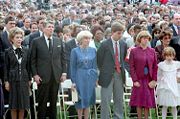
On the night of the disaster, President Ronald Reagan had been scheduled to give his annual State of the Union Address. He initially announced that the address would go on as scheduled, but under mounting pressure he postponed the State of the Union Address for a week and gave a national address on the Challenger disaster from the Oval Office of the White House. It was written by Peggy Noonan, and finished with the following statement, which quoted from the poem "High Flight" by John Gillespie Magee, Jr.:
| “ | We will never forget them, nor the last time we saw them, this morning, as they prepared for their journey and waved goodbye and 'slipped the surly bonds of Earth' to 'touch the face of God.' | ” |
Three days later, President Reagan with his wife Nancy traveled to the Johnson Space Centre to speak at a memorial service honoring the astronauts. It was attended by 6,000 NASA employees and 4,000 guests, as well as by the families of the crew. During the carefully planned ceremony, an Air Force band led the singing of "God Bless America" as NASA T-38 Talon jets flew directly over the scene, in the traditional missing-man formation. All activities were broadcast live by the national television networks.
The families of the Challenger crew organized the Challenger Centre for Space Science Education as a permanent memorial to the crew. Fifty-two learning centers have been established by this non-profit organization.
The City of Palmdale, the birthplace of the entire shuttle fleet, and its neighbour City of Lancaster, California, both renamed 10th Street East, from Avenue M to Edwards Air Force Base, to Challenger Way in honour of the lost shuttle and its crew. This was the road that the Challenger, Enterprise, and Columbia all were towed along in their initial move from U.S. Air Force Plant 42 to Edwards AFB after completion since Palmdale airport had not yet installed the shuttle crane for placement on the 747.
In addition, the City of Lancaster has built Challenger Middle School, and Challenger Memorial Hall at the former site of the Antelope Valley Fairgrounds, all in tribute to the Challenger shuttle and crew.
Recovery of debris
In the first minutes after the accident, recovery efforts were begun by NASA's Launch Recovery Director, who ordered the ships used by NASA for recovery of the solid rocket boosters to be sent to the location of the water impact. Search and rescue aircraft were also dispatched. At this stage, however, debris was still falling, and the Range Safety Officer (RSO) held both aircraft and ships out of the impact area until it was safe for them to enter. It was about an hour until the RSO allowed the recovery forces to begin their work.
The search and rescue operations which took place in the first week after the Challenger accident were managed by the Department of Defense on behalf of NASA, with assistance from the United States Coast Guard, and mostly involved surface searches. According to the Coast Guard, "the operation was the largest surface search in which they had participated." This phase of operations lasted until February 7. Thereafter, recovery efforts were managed by a Search, Recovery, and Reconstruction team; its aim was to salvage debris that would help in determining the cause of the accident. Sonar, divers, remotely-operated submersibles and manned submersibles were all used during the search, which covered an area of 480 square nautical miles (1600 km²), and took place at depths of up to 1200 feet (370 m).
By May 1, enough of the right solid rocket booster had been recovered to determine the original cause of the accident, and the major salvage operations were concluded. While some shallow-water recovery efforts continued, this was unconnected with the accident investigation; it aimed to recover debris for use in NASA's studies of the properties of materials used in spacecraft and launch vehicles. The recovery operation was able to pull 15 tons of debris from the ocean; 55% of Challenger, 5% of the crew cabin and 65% of the satellite cargo is still missing. Some of the missing debris still washes up on Florida shores, such as on December 17, 1996, nearly eleven years after the incident, when two large pieces of the shuttle were found at Cocoa Beach. Under Title 18, United States Code, Section 641 it is against the law to be in possession of Challenger debris and any newly discovered pieces have to be turned in to NASA.
On board Challenger was an American flag, dubbed the Challenger flag, that was sponsored by Boy Scout Troop 514 of Monument, Colorado. It was recovered intact, still sealed in its cargo bag.
The Australian aviator Bert Hinkler, the second person (after Charles Lindbergh) to fly solo across the Atlantic, had a connection with the Challenger disaster. A small piece of wood, a relic from one of Hinkler's hand-made gliders, was presented to the astronaut Don Lind in early 1986 as a token of appreciation for his coming to Bundaberg to contribute to the Hinkler Memorial Lectures. Lind in turn gave it to Dick Scobee, who took it with him on board the Challenger, inside a small plastic bag that he placed in his locker. After the explosion, the bag and the wood were recovered from the sea, identified, mounted, and later returned to the Hinkler Memorial Museum in Bundaberg. .
Funeral ceremonies
The remains of the crew that were identifiable were returned to their families on April 29, 1986. Two of the crew members, Dick Scobee and Michael J. Smith, were buried by their families at Arlington National Cemetery at individual grave sites. Mission Specialist Lt. Col. Ellison Onizuka was buried at the National Memorial Cemetery of the Pacific (also known as the "Punchbowl") in Honolulu, Hawaii. Unidentified crew remains were buried communally at the Space Shuttle Challenger Memorial in Arlington on May 20, 1986.
Rogers Commission investigation
The Presidential Commission on the Space Shuttle Challenger Accident, also known as the Rogers Commission (after its chairman), was formed to investigate the disaster. The commission members were chairman and former Secretary of State William P. Rogers, astronauts Neil Armstrong (Vice Chairman) and Sally Ride, lawyer David C. Acheson, aviation specialists Eugene Covert and Robert Hotz, physicists Richard Feynman, Albert Wheelon, and Arthur B. C. Walker, Jr., former Air Force general Donald Kutyna, Robert Rummel, Joseph Sutter, and test pilot Chuck Yeager. The commission worked for several months and published a report of its findings.
It found that the Challenger accident was caused by a failure in the O-rings sealing the aft field joint on the right solid rocket booster, which allowed pressurized hot gases and eventually flame to "blow by" the O-ring and make contact with the adjacent external tank, causing structural failure. The failure of the O-rings was attributed to a design flaw, as their performance could be too easily compromised by factors including the low temperature on the day of launch. More broadly, the report also considered the contributing causes of the accident. Most salient was the failure of both NASA and its contractor, Morton Thiokol, to respond adequately to the design flaw. This led the Rogers Commission to conclude that the Challenger disaster was "an accident rooted in history."
The report also strongly criticized the decision making process that led to the launch of Challenger, saying that it was seriously flawed. The report cited evidence that NASA managers did not know of Thiokol's initial concerns about the effects of the cold on the O-rings, and did not understand that Rockwell viewed the large amount of ice present on the pad as a constraint to launch. It concluded that:
| “ | ...failures in communication... resulted in a decision to launch 51-L based on incomplete and sometimes misleading information, a conflict between engineering data and management judgments, and a NASA management structure that permitted internal flight safety problems to bypass key Shuttle managers. | ” |
|
—Report of the Presidential Commission on the Space Shuttle Challenger Accident, |
||
Role of Richard Feynman
| “ | I took this stuff that I got out of your seal and I put it in ice water, and I discovered that when you put some pressure on it for a while and then undo it, it does not stretch back. It stays the same dimension. In other words, for a few seconds at least and more seconds than that, there is no resilience in this particular material when it is at a temperature of 32 degrees. | ” |
|
—Richard Feynman, |
||
One of the commission's best-known members was theoretical physicist Richard Feynman. His style of investigating with his own direct methods rather than following the commission schedule put him at odds with Rogers, who once commented, "Feynman is becoming a real pain." During a televised hearing, Feynman famously demonstrated how the O-rings became less resilient and subject to seal failures at ice-cold temperatures by immersing a sample of the material in a glass of ice water.
Feynman was so critical of flaws in NASA's "safety culture" that he threatened to remove his name from the report unless it included his personal observations on the reliability of the shuttle, which appeared as Appendix F. In the appendix, he argued that the estimates of reliability offered by NASA management were wildly unrealistic, differing as much as a thousandfold from the estimates of working engineers. "For a successful technology," he concluded, "reality must take precedence over public relations, for nature cannot be fooled."
Feynman later wrote about the investigation in his 1988 book What Do You Care What Other People Think?. The second half of the book covers the investigation and the issues between science and politics.
Feynman later reported that, although he had believed he was making discoveries about the problems at NASA on his own, he eventually realized that NASA or contractor personnel, in an apparent effort to anonymously focus attention on these problem areas, had carefully led him to the evidence which would support the conclusions on which he would later report.
U.S. House Committee hearings
The U.S. House Committee on Science and Technology also conducted hearings, and on October 29, 1986 released its own report on the Challenger accident. The committee reviewed the findings of the Rogers Commission as part of its investigation, and agreed with the Rogers Commission as to the technical causes of the accident. However, it differed from the committee in its assessment of the accident's contributing causes.
| “ | ...the Committee feels that the underlying problem which led to the Challenger accident was not poor communication or underlying procedures as implied by the Rogers Commission conclusion. Rather, the fundamental problem was poor technical decision-making over a period of several years by top NASA and contractor personnel, who failed to act decisively to solve the increasingly serious anomalies in the Solid Rocket Booster joints. | ” |
NASA response
After the Challenger accident, further shuttle flights were suspended, pending the results of the Rogers Commission investigation. Whereas NASA had held an internal inquiry into the Apollo 1 fire in 1967, its actions after Challenger were more constrained by the judgments of outside bodies. The Rogers Commission offered nine recommendations on improving safety in the space shuttle program, and NASA was directed by President Reagan to report back within thirty days as to how it planned to implement those recommendations.
In response to the commission's recommendation, NASA initiated a total redesign of the space shuttle's solid rocket boosters, which was watched over by an independent oversight group as stipulated by the commission. NASA's contract with Morton Thiokol, the contractor responsible for the solid rocket boosters, included a clause stating that in the event of a failure leading to "loss of life or mission," Thiokol would forfeit $10 million of its incentive fee and formally accept legal liability for the failure. After the Challenger accident, Thiokol agreed to "voluntarily accept" the monetary penalty in exchange for not being forced to accept liability.
NASA also created a new Office of Safety, Reliability and Quality Assurance, headed as the commission had specified by a NASA associate administrator who reported directly to the NASA administrator. George Martin, formerly of Martin Marietta, was appointed to this position. Former Challenger flight director Jay Greene became chief of the Safety Division of the directorate.
The unrealistically optimistic launch schedule pursued by NASA had been criticized by the Rogers Commission as a possible contributing cause to the accident. After the accident, NASA attempted to aim at a more realistic shuttle flight rate: it added another orbiter, Endeavour, to the space shuttle fleet in order to replace Challenger, and it worked with the Department of Defense in order to put more satellites in orbit using expendable launch vehicles rather than the shuttle. In August 1986, President Reagan also announced that the shuttle would no longer carry commercial satellite payloads. After a 32-month hiatus, the next shuttle mission, STS-26, was launched on September 29, 1988.
Although significant changes were made by NASA after the Challenger accident, many commentators have argued that the changes in its management structure and organizational culture were neither deep nor long-lasting. After the Space Shuttle Columbia disaster in 2003, attention once again focused on the attitude of NASA management towards safety issues. The Columbia Accident Investigation Board (CAIB) concluded that NASA had failed to learn many of the lessons of Challenger. In particular, the agency had not set up a truly independent office for safety oversight; the CAIB felt that in this area, "NASA's response to the Rogers Commission did not meet the Commission's intent". The CAIB believed that "the causes of the institutional failure responsible for Challenger have not been fixed," saying that the same "flawed decision making process" that had resulted in the Challenger accident was responsible for Columbia's destruction seventeen years later.
Impact
Use as case study
The Challenger accident has frequently been used as a case study in the study of subjects such as engineering safety, the ethics of whistle-blowing, communications, and group decision-making. It is part of the required readings for engineers seeking a professional license in Canada and other countries. Roger Boisjoly, the engineer who had warned about the effect of cold weather on the O-rings, left his job at Morton Thiokol and became a speaker on workplace ethics. He argues that the caucus called by Morton Thiokol managers, which resulted in a recommendation to launch, "constituted the unethical decision-making forum resulting from intense customer intimidation." Many colleges and universities have also used the accident in classes on the ethics of engineering.
Information designer Edward Tufte has used the Challenger accident as an example of the problems that can occur when information is presented unclearly. He argues that if Morton Thiokol engineers had more clearly presented the data that they had on the relationship between cold temperatures and burn-through in the solid rocket booster joints, they might have succeeded in persuading NASA managers to cancel the launch. Tufte has also argued that poor presentation of information may have affected NASA decisions during the last flight of the Columbia.
